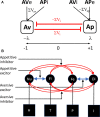Affective Valence Regulates Associative Competition in Pavlovian Conditioning
- PMID: 35359587
- PMCID: PMC8963338
- DOI: 10.3389/fnbeh.2022.801474
Affective Valence Regulates Associative Competition in Pavlovian Conditioning
Abstract
Evidence suggests that, in Pavlovian conditioning, associations form between conditioned stimuli and multiple components of the unconditioned stimulus (US). It is common, for example, to regard USs as composed of sensory and affective components, the latter being either appetitive (e.g., food or water) or aversive (e.g., shock or illness) and, therefore, to suppose different USs of the same affective class activate a common affective system. Furthermore, evidence is growing for the suggestion that, in competitive learning situations, competition between predictive stimuli is primarily for association with the affective system activated by the US. Thus, a conditioned stimulus (CS) previously paired with one US will block conditioning to another CS when both are presented together and paired with a different US of the same affective class, a phenomenon called transreinforcer blocking. Importantly, similar effects have been reported when steps are taken to turn the pretrained CS into a conditioned inhibitor, which activates the opposing affective state to the excitor that it inhibits. Thus, an appetitive inhibitor can block conditioning to a second CS when they are presented together and paired with foot shock. Here we show that the same is true of an aversive inhibitor. In two experiments conducted in rats, we found evidence that an aversive inhibitor blocked conditioning to a second CS when presented in a compound and paired with food. Such findings demonstrate that affective processes and their opponency organize appetitive-aversive interactions and establish the valences on which they are based, consistent with incentive theories of Pavlovian conditioning.
Keywords: Pavlovian conditioning; affect; appetitive-aversive interactions; incentive learning; motivation; prediction error; valence.
Copyright © 2022 Laurent, Westbrook and Balleine.
Conflict of interest statement
The authors declare that the research was conducted in the absence of any commercial or financial relationships that could be construed as a potential conflict of interest.
Figures




Similar articles
-
Appetitive-aversive interactions in Pavlovian fear conditioning.Behav Neurosci. 2012 Jun;126(3):404-22. doi: 10.1037/a0028341. Behav Neurosci. 2012. PMID: 22642885
-
Roles of Octopamine and Dopamine Neurons for Mediating Appetitive and Aversive Signals in Pavlovian Conditioning in Crickets.Front Physiol. 2017 Dec 12;8:1027. doi: 10.3389/fphys.2017.01027. eCollection 2017. Front Physiol. 2017. PMID: 29311961 Free PMC article. Review.
-
How common is a common error term? The rules that govern associative learning in sensory preconditioning and second-order conditioning.Front Behav Neurosci. 2022 Oct 14;16:954646. doi: 10.3389/fnbeh.2022.954646. eCollection 2022. Front Behav Neurosci. 2022. PMID: 36311862 Free PMC article. Review.
-
Nucleus accumbens neurons dynamically respond to appetitive and aversive associative learning.J Neurochem. 2024 Mar;168(3):312-327. doi: 10.1111/jnc.16063. Epub 2024 Feb 5. J Neurochem. 2024. PMID: 38317429
-
An appetitive conditioned stimulus enhances fear acquisition and impairs fear extinction.Learn Mem. 2016 Feb 16;23(3):113-20. doi: 10.1101/lm.040337.115. Print 2016 Mar. Learn Mem. 2016. PMID: 26884229 Free PMC article.
Cited by
-
Effects of predictive and incentive value manipulation on sign- and goal-tracking behavior.Neurobiol Learn Mem. 2023 Sep;203:107796. doi: 10.1016/j.nlm.2023.107796. Epub 2023 Jun 28. Neurobiol Learn Mem. 2023. PMID: 37385521 Free PMC article.
-
The positive valence system, adaptive behaviour and the origins of reward.Emerg Top Life Sci. 2022 Dec 9;6(5):501-513. doi: 10.1042/ETLS20220007. Emerg Top Life Sci. 2022. PMID: 36373858 Free PMC article. Review.
References
-
- Dickinson A. (1977). Appetitive-aversive interactions: superconditioning of fear by an appetitive CS. Q. J. Exp. Psychol. 29, 71–83. 10.1080/00335557743000044 - DOI
LinkOut - more resources
Full Text Sources

